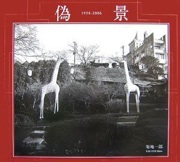
Ichiro KIKUCHI
"Hyoukei"
Pages: 120 / photos:112
Size: 260x270x20mm / hardcover
Price: 3,800JPY
Release Date: August 2014 |
|
When you get down to it, you can say that we encounter the “out of place landscape” every day, yet most of the time, we are indifferent to those scenes. It is certain we have inherited this indifferent attitude from our forefathers. But, instead of discussing the rights and wrongs of that attitude, I think we should fully enjoy the feeling of strangeness the “out of place landscape” creates.
The “out of place landscape” should be appreciated with its mystery intact, for sometimes the scene reveals something that is beyond human understanding. There was once, in a modern art genre, a conceptual art called “Earthworks,” a form of artwork in which the bare nature was transformed into an artifact having a little odd or “out of place” effect on the landscape, and the work was often presented by aerial photographs. Certainly this type of art requires the action of both creators and viewers “recognizing the view.” However, the “out of place landscape” or the similar scene we encounter every day keeps being there quietly as it is, whether it is seen as art or not. That is quite something suggestive, I think.
"Excerpt from the comment of art critic, Kazuo Saito" |

Ichiro KIKUCHI
"Gikei 1998-2006"
Pages: 86 / photos: 75
Size: 234x207x13mm / hardcover
Price: 2,900JPY
Release Date: January 2007
Web-site |
|
From this book's title and the cover--which features two fake giraffes looking at each other--it's clear that it's not going to feature pastoral images of the lush Japanese countryside! Kikuchi is concerned with uncovering something about the relationship between humans and nature, which is especially pertinent in Japan, where, to take one example, all but a few rivers have been enclosed in concrete.
Thankfully, this work is not dogmatic in its presentation, as we see different relationships between the natural and man-made worlds. Sometimes we see largely natural scenes with only a little bit of construction, while in other photos the man made structures themselves are presented as the "landscape," with the odd tree or rock formation looking out of place. Indeed, the work passes no judgment on its subjects; it is still possible to speak of a kind of beauty here, even as the photos document a threatened idea of landscape. |